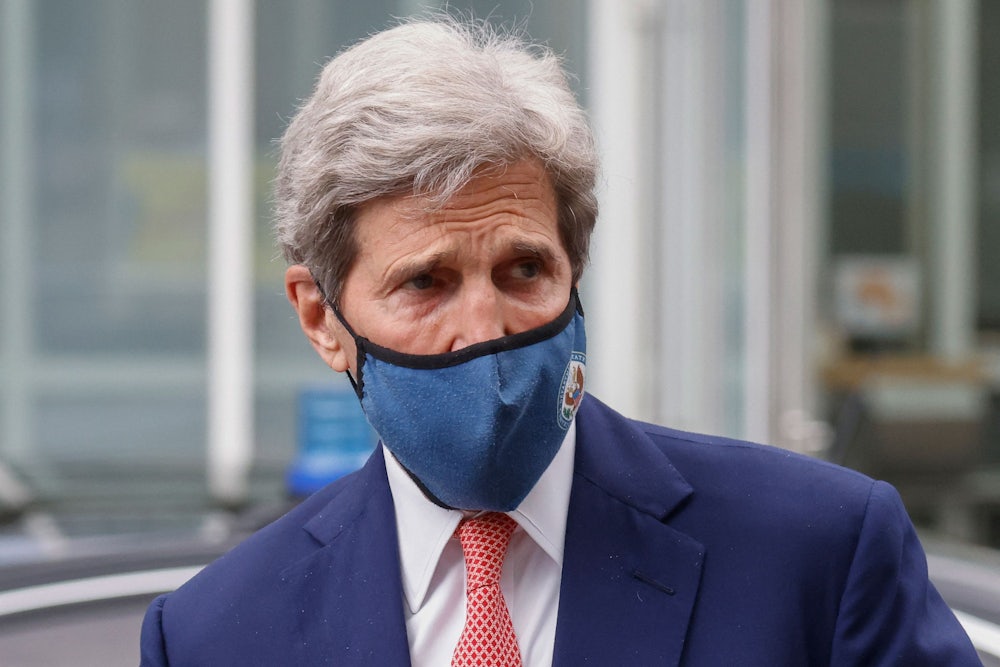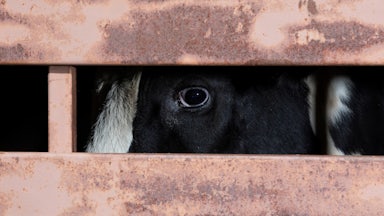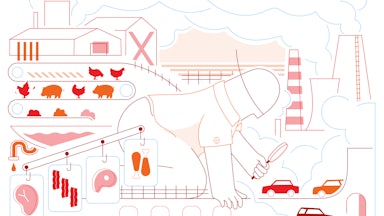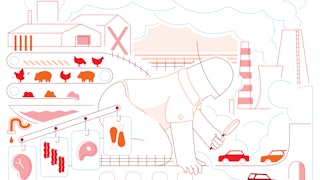John Kerry’s interview with the BBC’s Andrew Marr on Sunday was a masterclass in equivocation. The first-ever special presidential envoy for climate replied to each of Marr’s clear, direct questions on how the United States plans to phase out fossil fuels with vague references to President Biden’s commitment to decarbonization and shifting to renewable energy. Asked whether the U.S. would sign a pledge to stop using coal, he replied, “Well, over time that’s happening anyway.” Asked for a date for closing coal-fired power plants, he responded, “As soon as it’s feasible.” Even the alleged facts he cited in the interview were bizarre: In the past few days, for example, the climate community has pilloried Kerry’s unsubstantiated claim that “50 percent of the reductions we have to make to get to net-zero […] are going to come from technologies that we don’t yet have.”
But perhaps the most telling exchange concerned agricultural emissions.
“Isn’t the simple, slightly brutal truth that you’re going to have to tell Americans to eat less meat?” asked Marr.
“Not necessarily,” replied Kerry, “because there’s a lot of research being done now that will change … the way meat is produced. Cattle are herded and fed. There’s research being done that actually reduces the amount of methane.”
What exactly Kerry was referring to remains unclear, since he quickly pivoted to other talking points and meat didn’t come up again. It should have. Climate policy does need to address meat production and its outsize ecological hoofprint. And insofar as Kerry was trying to talk about solutions like so-called regenerative agriculture or adjusting livestock feed, it’s important for people to understand just how dubious these so-called solutions currently are.
There seems to be a growing consensus among climate experts that meat is a topic to be given wide berth, be it to head off a culture war with conservatives or to avoid alienating the meat-loving public. This flies in the face of a growing consensus in the peer-reviewed literature on the relationship between food systems and climate: Animal agriculture contributes about 15 percent of total global greenhouse gas emissions. We need to drastically reduce our meat consumption if we are to keep food production within planetary limits and in line with climate targets. For example, the EAT-Lancet diet, the result of a landmark collaboration between a commission of climate change experts and the medical journal The Lancet, recommends a maximum of 14 grams of beef per day (less that the current global average of 25 grams and far less than the American average, 102 grams).
Meat’s perennial status as the third rail in climate politics has recently been bolstered by emerging claims that the environmental impact of animal agriculture—and specifically methane emitted by cows—can be mitigated. Most of this conversation (and what Kerry was probably referring to with “cattle are herded and fed”), has been about incorporating methane-reducing feed additives into cows’ meals and shifting their production to a grazing-based, “regenerative” model of animal husbandry.
But as with any proposed climate solution, we need to ask two questions about low-emission meat. First: Does the science back the hype? Second: Can it actually be implemented at scale in a way that produces a meaningful difference?
In the case of feed, a scientific cottage industry has sprung up around the potential of using additives like seaweed to reduce the methane content of cows’ belches. There is solid scientific research that suggests that such additives work, reducing cows’ emissions by up to 80 percent in experiments. It’s the sort of number that makes for glowing headlines and effusive claims that climate-guilt-free beef is back on the menu.
But practical implementation is a different story. As Matthew Hayek, a professor of environmental studies at New York University, and I wrote for Wired in March, cattle feed additives work best when mixed with grain-based feed on feedlots, where cattle spend the last few months of their lives being fattened for slaughter. That leaves the majority of their lives, when they graze and emit most of their methane, completely unaffected. It’s also unclear how feasible it would be to introduce feed additives into grazing cattle’s diets.
That drops the widely touted 80 percent figure to something closer to 10 percent. That, in turn, would only make a real difference if algae production was scaled by many orders of magnitude and fed to the world’s population of approximately one billion cattle, raising thorny questions about the economic feasibility and ecological side effects of creating all-new value chains for a brand-new monocrop. Even if these questions could be answered, the total global reductions promised by changes in feed would still fall short of the climate targets in the EAT-Lancet calculations, meaning we’d have to eat less meat anyway, in addition to making sure the meat we did eat came from potentially more expensive, low-methane sources. And there’s one more problem. Given that feed additives work best on feedlots, they fit best within an industrial farming paradigm, making it ideal for the conventional meat industry’s greenwashing campaign. But it’s not clear how that fits with the lower-emission, nonindustrial grazing Kerry seemed to be referring to with his reference to herding cattle differently.
Regenerative animal agriculture is the buzz in foodie and climate circles these days, often touted as a solution to all the ills of conventional, industrial agriculture. In recent years the term has become something of an empty signifier, referring to a wide range of food production systems generally considered to be alternatives to industrial agriculture, ranging from holistic grazing to so-called sustainable intensification.
Generally speaking, the claims underlying the climate benefits of nonindustrial cattle grazing are that grazers help create healthy soil, which can become a carbon sink, sequestering more planet-warming gases, in the form of carbon dioxide, than the cattle emit in the form of methane. Everyone from proponents of small-scale agrarianism to climate thought leaders like Kerry loves this idea. The problem is that there is scant proof that these claims are actually true. Smaller-scale, regenerative farming systems do have some potential environmental benefits, like improving soil fertility or reducing reliance on monocrop feed and antibiotic use, but climate change mitigation is not at the top of that list. Holistic grazing systems also run into a logistical problem. A recent study suggests that transitioning from conventional cattle production to exclusively pasture-based systems to supply the same amount of beef as conventional systems currently do would require producing 30 percent more cattle. Or, to think of it another way: Currently available U.S. pastureland could only support producing about 27 percent of our beef supply if all cows were fully pasture-raised. In terms of magically replacing all our current beef with environmentally friendly alternatives, this is a nonstarter.
Proponents of regenerative agriculture also offer no mechanism for reducing the amount of mass-produced meat consumers currently buy. The alternative food system mantra of “less meat but better meat” runs into the same theory-of-change problem that vegans have: It relies on convincing individual consumers to make more ethical choices in the market. Consumers might indeed buy regeneratively raised meat as a treat, and more wealthy consumers might switch entirely, but that doesn’t mean the average consumer will replace their current consumption of conventionally raised meat. As a recent op-ed in The Washington Post by a regenerative farmer conceded, the fact of the matter is that nonconventional meat is more expensive and less accessible than conventional meat, making it an ethical luxury. Regenerative agriculture, whatever its benefits might be, simply isn’t the easy or scalable fix its proponents want it to be.
The biggest problem, though, is how all this hyping of “green” meat plays into the hands of the conventional meat industry, which is already using tactics from the oil industry’s playbook to oppose environmental regulations and challenge climate science. This “merchants of doubt” approach—to use the term developed by Naomi Oreskes and Erik Conway—relies on casting a shadow of doubt over criticism (for example, those saying “we need to eat less meat”) to continue with business as usual. And business as usual involves not just ever-increasing emissions but pollution that poisons waterways and contributes to premature deaths for local populations, brutal working conditions that involve permanent injuries and exposure to Covid-19, and widespread cruelty to animals. As long as leading voices like Kerry’s tell the public that meat can be redeemed, Big Meat wins.
To return to Marr’s question, the brutal truth is that Americans do need to eat far less meat. How much less is an open question: EAT-Lancet recommendations of limiting beef to 14 grams a day and cutting down on other meats could be a starting point, or you could argue for cutting 99 percent of current consumption (since upward of 99 percent of meat in America is factory-farmed) and getting the remaining 1 percent exclusively from regenerative sources, or you could consider ethical claims about animals’ rights and cut out meat entirely.
In any case, it’s a conversation we need to have, and it’s time for the climate movement to talk about this honestly and grapple with the implications. The sooner we admit this, the sooner we can start making real progress on reducing our food system’s climate footprint. This can take the form of systemic solutions like removing various government supports for conventional animal agriculture, supporting the development of alternative proteins or supporting legumes, or nudging consumers to choose healthier diets, which would also necessitate tackling the questions of food cost and access, especially for marginalized populations. It also involves using the simplest solution, the one that doesn’t require any technological advances at all: leaving meat off our plates.








